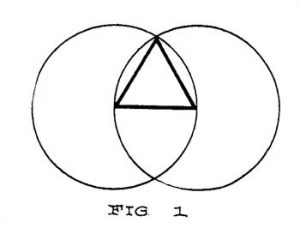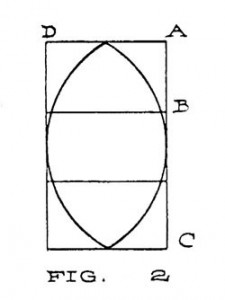The oval form of the VIII° symbol is of great significance and has been known for many centuries as the Vesica Piscis, or fish’s bladder, probably to conceal its true meaning.
If we go back to the early stages of symbolism we find the circle used to represent eternity, and to man’s conception, there are two eternities; that of the ages past, and that of the future. Two equal circles would symbolize these infinite periods of time and their intersection forms a cavity, which represents that attainment, which is the aim and object of every man’s sojourn on this earth, and which in Christian symbolism, is called the birth and life of Christ in the soul.
The Vesica Piscis is an almost universal symbol for the Christ and this accounts for the use of the oval form on seals of ecclesiastical institutions.
The early Christians were anxious to include symbols of their religion in their cathedrals and churches, and this is the reason for the rise of Gothic architecture in which the windows were built in a pointed form to include this symbol of the Christ.
As the new covenant of the Avatar Jesus is said to have superseded that of Moses, so do we find the Christian degrees in Masonry beyond the craft or universal degrees, and in the same way Gothic architecture came after the square or Norman type.
The diagram shown above is the figure for the first proposition of the first book of Euclid, and all the subsequent propositions depend upon this fundamental one, which is to describe an equilateral triangle on a given line. When described in this way, the triangle forms a fitting symbol of the Christian Trinity.
If we enclose the Vesica Piscis in a rectangle, and divide that rectangle into three equal parts as shown in Fig. 2, we find that the ratio of the sides of one of the smaller triangles is equal to the ratio of the sides of the whole rectangle. In other words, the ratio of AB to AD is the same as the ratio of AD to AC, which ratio is that of 1 to the square root of 3. This is very important and significant fact and makes the symbol particularly referable to the Triune God.
This fact was evidently known to the builders of the Middle Ages for we find that the naves of many of the old cathedrals and churches were built with their sides in this same proportion. Rosslyn Chapel, in England is a famous example of this ratio.


